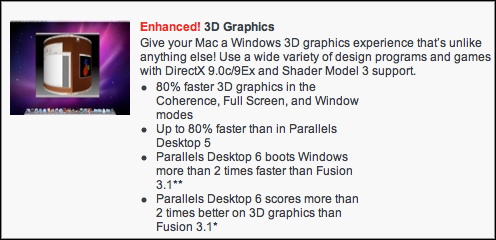The extremely popular Parallels Desktop is a virtualization solution that allows Mac users to run Windows applications. Every subsequent version promises performance gains. During our upgrade, we decided to do a little benchmarking to see if our performance saw their promised improvement.
Many Mac users try out parallels to run Windows-based games. Parallels frequently pushes out paid updates that claim to improve speed and video features.
We tested Parallels Desktop Version 5 versus Version 6 on one of our Macbook Pro machines.
Here are the video claims for Version 6:
– 80% faster 3D graphics in the Coherence, Full Screen, and Window modes
– Up to 80% faster than in Parallels Desktop 5

Eighty-percent is pretty impressive!
We used the standard benchmarking program 3dMark06 for our tests.
Testing System:
System Model Parallels Software International Inc. Parallels Virtual Platform
Processor Intel(R) Core(TM)2 Duo CPU T9600 @ 2.80GHz
Physical Memory 2 GB
Graphic Parallels Display Adapter (WDDM)
Video Memory 264 MB
Operating System Windows 7 Home Premium (6.1.7600) 64-bit
Application 3DMark06 – Professional Edition
This is the maximum video memory allowed. Two GB is the high end of memory recommended.
Results:
Version 6 vs (Version 5) **percent change**
< Main Test Results >
3DMark Score 1,334.0 (1,035) 3DMarks**+29%**
SM2.0 Score 464.0 (477)
HDR/SM3.0 Score 504.0 (263) **+92%**
CPU Score 1,272.0 (1,279)
Game Score 0.0 (0.0) points
< SM2.0 Graphics Tests >
GT1 - Return To Proxycon 3.5 (3.6) FPS
GT2 - Firefly Forest 4.2 (4.3) FPS
< CPU Tests >
CPU1 - Red Valley 0.4 (0.4) FPS
CPU2 - Red Valley 0.6 (0.6) FPS
< HDR/SM3.0 Graphics Tests >
HDR1 - Canyon Flight 4.2 (1.9) FPS **+121%**
HDR2 - Deep Freeze 5.9 (3.3) FPS **+79%**
< Feature Tests >
Fill Rate - Single-Texturing 1,317,167,602.5 (1,325,438,354.5) texels/s
Fill Rate - Multi-Texturing 1,656,471,801.8 (1,649,656,494.1) texels/s
Pixel Shader 33.7 (32.6) FPS
Vertex Shader - Simple 65,924,110.4 (67,047,706.6) vertices/s
Vertex Shader - Complex 27,637,559.9 (28,535,263.1) vertices/s
Shader Particles (SM3.0) 15.2 (-1.0) FPS
Perlin Noise (SM3.0) 15.0 (3.3) FPS
< Batch Size Tests >
8 Triangles 745,998.8 (600,352.6) triangles/s
32 Triangles 2,723,455.9 (2,172,276.5) triangles/s
128 Triangles 11,718,804.4 (8,095,548.6) triangles/s
512 Triangles 46,427,562.7 (32,311,672.2) triangles/s
2048 Triangles 66,384,063.7 (66,035,568.2) triangles/s
32768 Triangles 68,376,327.5 (67,817,832.9) triangles/s
Conclusions:
I’m a huge fan of Parallels. Version 6 provides a ton of new features and has an overall better feel.
Version 6 certainly supports Shader Model 3 (SM3) now and that shows up in the scores. Almost every SM3 score in the benchmarks show impressive improvements. Games that heavily depend on Shader Model 3 should see visible gains. Other games are unlikely to see large benefits.
